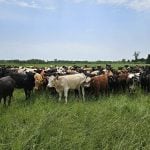China | Reuters – China, the world’s top pork producer, has culled 200,000 pigs so far following outbreaks of highly contagious African swine fever in the country, a Chinese animal health official said on Friday.
While that represents only a tiny portion of the nearly 700 million pigs slaughtered in China each year for sale as pork, restrictions on the transport of animals to curb the spread of the disease have created tight supplies in some parts of the country.
China has seen 41 outbreaks of the disease, affecting 27 cities across the country, Wang Zongli, deputy director of the China Animal Health and Epidemiology Center, said at a conference in Zhengzhou. He warned that both detection and prevention of the disease, which can be deadly to pigs but does not harm humans, was very difficult.
Read Also

Manitoba Crop Report: More scattered rains across the province
More scattered showers across Manitoba helped crops advance in their development during the week ended July 13, 2025.
The comments came as the agriculture ministry said that prices of pork could rise amid ongoing outbreaks of African swine fever.
China has culled pigs on farms infected by the disease as well as those on farms within a three-km (1.9 mile) radius of the outbreaks, Wang told Reuters.
Many outbreaks of the disease have occurred in the northeast, particularly in Liaoning province, an area that typically trucks a significant portion of its pigs further south for slaughter closer to consumption centres.
Wang said research showed that transport was one of the main risks for spreading disease.
“We need to focus more on slaughtering close to production,” he said, in order to reduce the long distances pigs are currently transported.

















